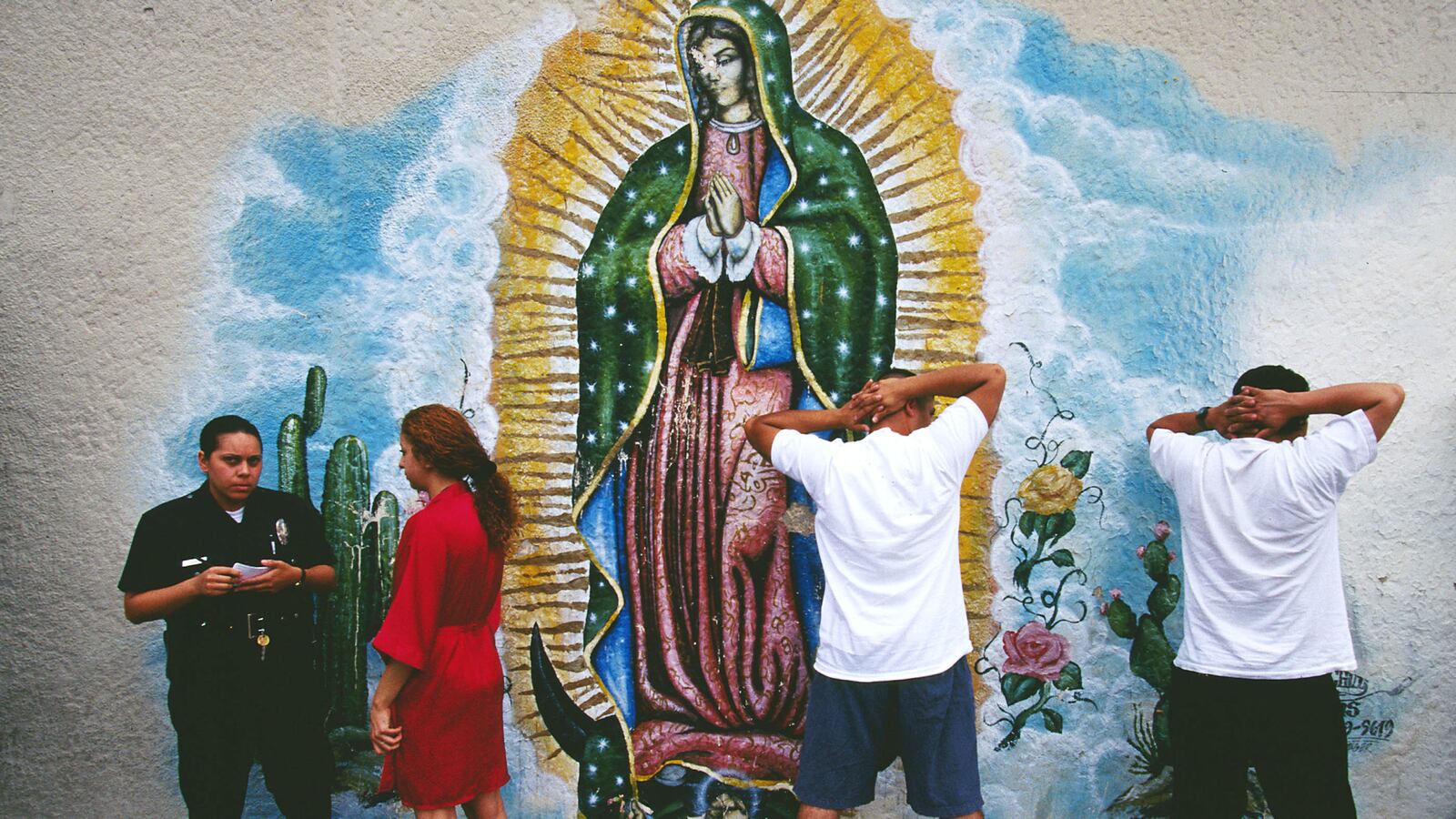Two years after seven do-or-die loyals of one of L.A.’s original Latino gangs allegedly tossed Molotov cocktails into their neighbors’ homes to “get the n—-ers out of the neighborhood,” the law finally caught up with them.
On Thursday, the feds unsealed what is being called the one of “largest civil rights indictments in local history,” alleging that the gang members ruthlessly waged a race-fueled campaign against innocent African American families—all with young children—to get them off their prized turf.
The pyrotechnic perpetrators, members of the storied Big Hazard or Hazard Grande gang, include Carlos Hernandez, 31, known by his street names “Creeper” or “Rider”; and his 25-year-old counterpart Francisco Farias, who goes by the moniker “Bones.”
The two alleged ringleaders face a maximum of “life in prison,” according to the court papers. His associates face conspiracy charges of violating civil rights as well as using fire and explosives, aiding and abetting, attempted arson of federal property, using fire and carrying explosives, violent crime in aid of racketeering, and interference with housing rights.
Five other accused 20-something co-conspirators named in the Boyle Heights hate crime are Jose “Lil’ Moe” Saucedo, Josue “Malo” Gribay, Edwin “Boogie” Felix, Jonathan “Pelon” Portillo, and Joel “Gallo” Monarrez.
According to the 25-page indictment, all seven of the suspects, as well as “other members and associates of the Big Hazard gang known and unknown to the Grand Jury,” got together sometime in May 2014 to hatch the hellraising.
It was the duty of all Big Hazard gangbangers to keep their territory—the post-World War II public housing buildings known as Ramona Gardens, near Hazard Park—free from African-Americans, prosecutors allege.
Big Hazard was founded back in the 1940s and has about 350 members. The gang, which has adopted the biohazard symbol, is staunch allies with the “Mexican Mafia,” or “La Eme,” and believes its duty is to wield its “authority over its territory,” according to the criminal document.
For seven decades, the gang has earned a rep with law enforcement agencies for committing extortion, robbery and running dope from its Ramona Gardens HQ.
According to the criminal complaint, the gang imposed “unwritten rules regarding the control of Hazard territory, including that African-American residents reside in Ramona Gardens at the pleasure of Hazard.” Should any black tenants “offend” any Hazard members, they faced “retaliation and expulsion from Ramona Gardens.”
It wasn’t just African Americans who were warned, according to the criminal document. Mixed-race tenants were considered instant outsiders and were always on notice. “Members of the Hazard gang…would confront African American residents, including mixed-race children, and individually and collectively threaten them by telling them that they were not welcome in Hazard gang territory, namely Ramona Gardens, and that they risked harm if they remained as residents.”
Putting heat behind the threats, Hernandez allegedly led his crew to perform an eviction by smoking the families out of their homes, telling his six counterparts “they were going to use Molotov cocktails to firebomb” homes where African-American families were residing.
Their May meeting was the first of several sessions to tool up and plan their explosive villainy.
On May 11, 2014, which also happened to be Mother’s Day, Hernandez and other Big Hazard gangsters “met at a gang location in Hazard territory to prepare for the firebombing…” the criminal complaint alleges.
Hernandez, as the alpha leader, allegedly “distributed disguises, gloves, and materials for the firebombs” to his fellow gang members, and they were all supposed to be inspired by the mission: the firebombing was to “get the n—-ers out of the neighborhood,” he allegedly told them.
Each was assigned duties, which included breaking windows “to make clean entries,” then “igniting the firebombs” and “throwing the firebombs into the residences through the broken windows in order to maximize damage,” the complaint allegedly.
The craven crooks allegedly tried to stump detectives by committing the arson without a trace. They “deliberately left behind their cellular telephones prior to engaging in the firebombing in order to thwart law enforcement’s ability to track their movements,” the papers allege.
At around midnight the following day, Hernandez, packing a semi-automatic pistol, was behind the wheel of a “used stolen van to transport” the marauders. They allegedly moved in stealth mode to circumvent the surveillance cameras at the federal housing project. According to the complaint, Hernandez and company drove the hot van “via route where they knew the security cameras inside of Ramona Gardens would be unable to record them” as they engaged in their wrath.
The Big Hazard Seven struck four homes that night, the papers say.
The first firebomb was tossed inside an apartment, where a mother was cuddling with her baby as her four other children lay fast asleep in the the bedrooms. The shards of glass smashed to the floor, and the firebomb landed where the mother and baby had been lying—she had moved when she heard the window break.
Another nearby unit, according to the complaint, was hit in sequence. Inside were two adults and “minor children.”
Hernandez himself allegedly went for the third apartment, where an elderly adult and grandchildren lived.
Apparently Hernandez bungled his own firebomb operation and miraculously, every targeted victim escaped unscathed.
He was successful in breaking the window of the apartment, but when he tried to toss the Molotov cocktail, he “cut his right arm on the broken glass, causing it to bleed profusely…”
The accused firebomber would later have to be rushed to White Memorial Hospital to stem the bleeding from his right arm, the complaint states.
While the Hazard crew’s alleged handiwork remained shrouded in secrecy, the FBI and LAPD, along with the ATF and IRS, moved in on the gang during the predawn hours of Dec. 11, 2014 in what was dubbed Operation Resident Evil. Law enforcement raided Ramona Gardens and rounded up almost 30 alleged gang members and slapped them with a slew of charges, including racketeering, which carry heavy prison sentences.
Back then the indictment recorded in grave detail the blatant hate Big Hazard unleashed against outsiders, and especially African-Americans, allegedly tagging graffiti: “Vario BHR no blacks.”
This week’s bust marks a major one-two counterpunch for law enforcement.
Principal Deputy Assistant Attorney General Vanita Gupta, who heads the DOJ’s Civil Rights Division, didn’t mince words. “This is a hate crime,” she said in a statement. “Such violence and intimidation have no place in our society.”





